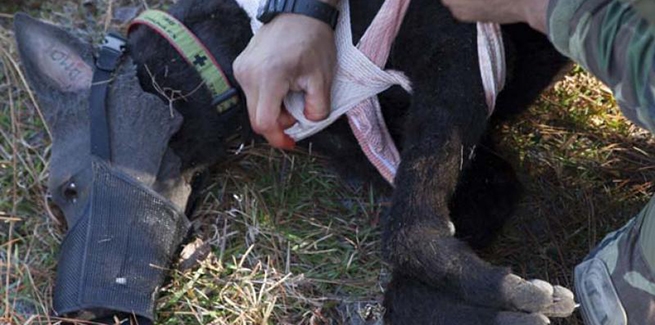The US marines unleash a new “robot dog” to help wounded military working dogs

Multipurpose canines (MPC) are the Navy Seals of military working dogs. Highly trained, uniquely skilled, and almost unstoppable.
Strapped to their human handlers, they leap from helicopters and rappel down sheer cliffs. They sniff out explosives, track down enemy insurgents, and they’ll take a bullet to protect the men and women they serve with.
Which means they get hurt.
So the United States Marine Corps Forces, Special Operations Command (MARSOC) got together with private industry to develop a new high-tech robot dog prototype to help train MPC handlers to better tend their dogs’ wounds—and sometimes save their lives—when they’re injured in action.
The robot canine training dummies looks like a Belgian Malinois—a breed similar to a German shepherd, but smaller. The breed is much favored by US Navy Seals—a Belgian Malinois named Cairo accompanied SEAL Team Six in their raid on Osama bin Laden’s compound.
In the past, MPC handlers trained with Critical Care Jerry dogs, an emergency room veterinary training manikin that allowed them to practice a variety of emergency medical procedures like intubation, splinting, and resuscitation. But Jerry dogs look like big, stuffed toys, and they don’t move, which limits their effectiveness for medical aid training.
And MPC handlers need effective training. They need to be able to treat any injury and stabilize the dog until they can get him out of the field and back to a veterinarian.
“Our handlers are the first line of aid for their dogs when deployed,” a MARSOC veterinarian said. “They are the first responders.”
In contrast to Critical Care Jerry, the new robot dog prototypes are strikingly realistic (see photo above). Their limbs move. Their lungs expand. And they bleed.
Although it’s not real blood, it provides handlers with a shockingly real-life battlefield experience and allows them to practice dealing with worst-case scenarios like eviscerations. And when they correctly administer proper medical aid, handlers can actually see the robot dogs’ vital signs stabilize.
The robot dogs also provide opportunities to practice dealing with less nightmarish scenarios, like doing tracheotomies or intubations, administering full CPR (the robots have reactive responses, like breathing), and inserting IVs. Limbs can be swapped out to simulate different injuries. The dog even makes barking or whining noises to enhance the realism.
Handlers began training with the prototypes in early December. Full scale production is scheduled to start in March of next year, after designers have a chance to go over the handlers’ feedback. The training dog could be available to deploy to the field as early as April.
MPC handlers can’t wait.
“[Having this capability during training] helps you not second guess yourself when deployed,” a MARSOC MPC handler said. “When it comes to needing it on the battlefield, having that muscle memory is important when you’re in the middle of the action.”
The prototypes don’t have a name, yet. But Critical Care Cairo might be one to consider.
Photo Credit: © Cpl. Bryann K. Whitley



